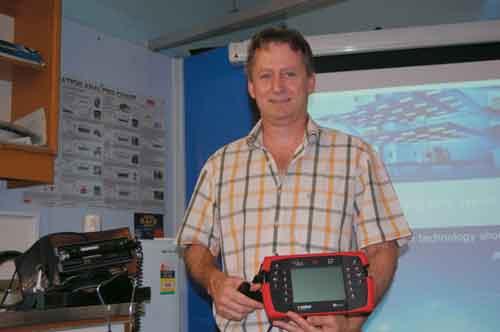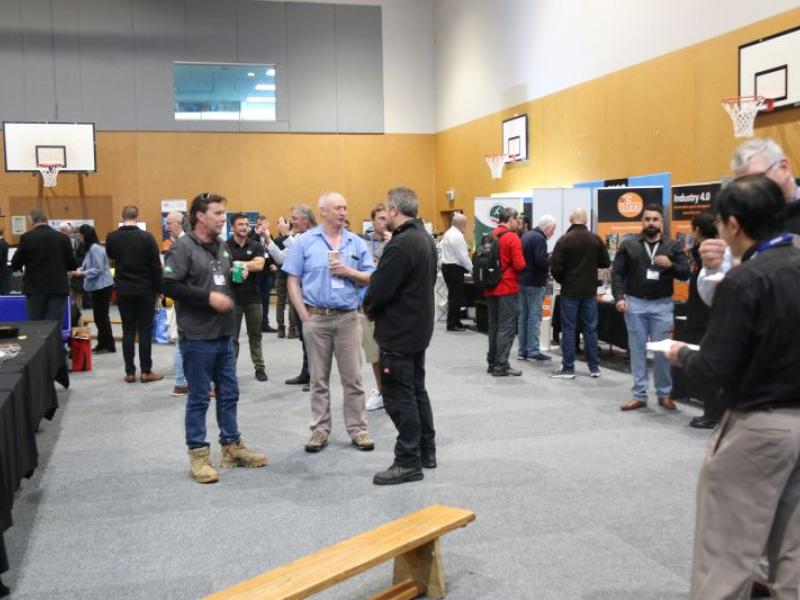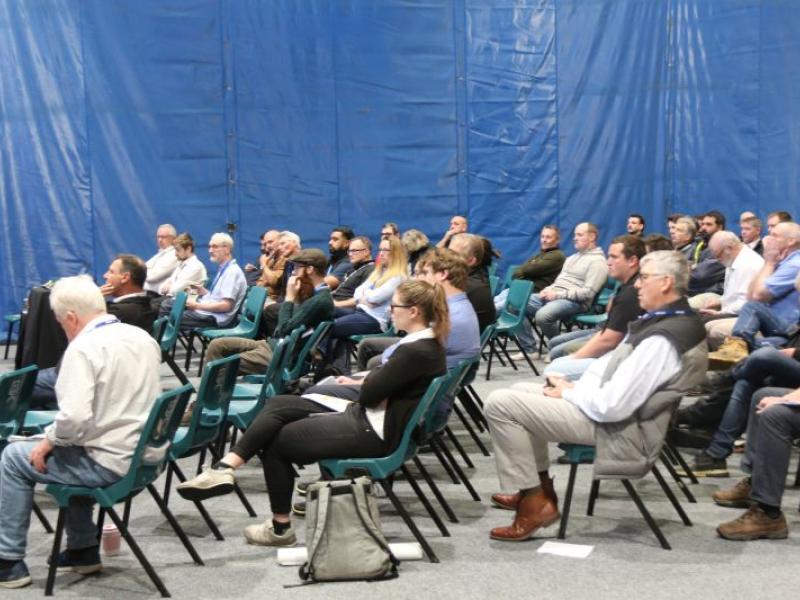Condition monitoring as such does not improve the reliability of a machine. But it can provide the necessary data to identify and deal with the root cause of a problem. Editor Stefan Richter talked to Clyde Volpe from the Vibration Institute of Australia about reliability maintenance.
DEMM: While teaching vibration analysis here at the MIT you mentioned that you don’t particularly like the term condition monitoring. Why is that?
CV: Condition monitoring is an old technique we used to do to collect overall values from machines, like overall vibration or overall temperature and then trend them. If they went up we would then often plan to change the machine. Because of this CM is perceived by many engineers and managers as the collection of a value and trending it like a temperature reading or an overall vibration reading. When we are measuring these parameters with simple overall value measurement devices though we can only tell that the condition has changed, but not why it has changed. Today we have much more sophisticated analysers to do this and they are capable of much more than those simple devices of past days. These are referred to as predictive maintenance tools, they are way more powerful and can isolate the actual problem by indicating if it is unbalance or misalignment, soft foot, a bearing outer race fault or loose foundations, for example. We can use these tools to predict what is actually wrong and what has caused it, and not just report that the vibration or temperature is increasing, which actually tells you nothing about the specific problem. By definition, condition monitoring and predictive maintenance are not the same thing.
However, knowing the condition of a machine and predicting an impending failure does not improve the reliability of the machine. Knowing when a machine is going to fail is great, but you have not extended its life. Very often the fact that we are ‘doing condition monitoring’ holds us back from going forward and analysing the gathered data and ultimately finding and dealing with the root cause that is responsible for the failure in the first place. That’s why I don’t like the term CM. Very often we are just too busy doing condition monitoring and collecting data and miss the bigger picture which is to raise the reliability.
DEMM: What should we be doing then?
CV: Reliability maintenance, that’s what we should be doing! The biggest thing holding us back is our resistance to change. We need to change from our present condition monitoring focus to one of reliability, but this will require substantial changes to the tradition CM approach. It’s time we moved on with a new approach and embraced the change.
DEMM: Could you expand on that?
CV: We ought to ask ourselves: What factors are affecting my reliability and what do I have to do to improve it? That’s precision or reliability maintenance. The word precision implies that something is done correctly, properly, precisely. This kind of maintenance focuses on things like precision balancing and alignment, soft foot correction, setting up proper foundations for machinery, correct lubrication, proper servicing and repairs, etc. When you merely gather machine data you’re not doing reliability maintenance. But you have to monitor the condition of the machine anyway, because if you know its condition, you can plan the adequate response to solve the cause and not just the problem. Detecting an increased vibration level of a bearing is a problem, and installing a new bearing might solve it for a while. But what caused it in the first place? Could it be misalignment, imbalance, or bad lubrication practises? When the data is collected, analysed and interpreted correctly, predictive maintenance can point to the root cause of a problem and offers the reliability maintenance engineer a powerful toolkit to do his job properly.
DEMM: What exactly is contained in this reliability toolbox?
CV: A reliability maintenance engineer needs tools to do his job, much like a mechanic needs tools to do his. His tools should include the whole technology group: vibration analysis, oil analysis, infrared thermography, ultrasonics, laser alignment, precision balancing, etc. The more the better. There isn’t one tool that’s going to fix everything. A reliability maintenance engineer with only a computer in front of him is hopeless, all he can do is calculate reliability, but he can’t improve it. This toolbox will give him the tools to drive up reliability, which in turn drives availability, which is ultimately what we want. The better he knows how to use these tools, the better a position he will be in to help achieve this.
But the tools need to be utilised properly and to their full capabilities. Some companies buy really good vibration analysers and use them as data collectors – they are more simply using them as a condition monitoring tool. The engineer has to determine all the ways in which existing equipment can fail and choose the predictive maintenance technology from the toolbox that can detect the respective failure mode. If there is a lot of electrical equipment, vibration analysis is probably not the best predictive tool to use. If you have lots of gearboxes, I would be using vibration and oil analysis. Are there lots of electric motors? You should consider doing motor voltage and motor current signature analysis together with vibration analysis. If there are a lot of motors and fans, I would focus on vibration analysis balancing and alignment. The equipment ultimately determines the suitable reliability maintenance tool you should use.
DEMM: Is reliability maintenance the predominant form of maintenance in Australia and New Zealand at the moment?
CV: It depends on the industry type. For example, the mining industry in Australia is heavily investing in this concept and reaping massive rewards for their efforts. But for many of the others, unfortunately I have to say no condition monitoring is still their focus; that said, the last two years have seen a real positive change towards this idea. Many ANZ companies are cutting the maintenance budget rather than investing in predictive maintenance, or worse still, things are still done on the old philosophy of condition monitoring and one or two parameters measured and trended. It is also not very conducive to improving reliability when these technologies are only applied to a small number of machines. Many companies just dabble in predictive maintenance, but expect big results from their half-hearted efforts.
Very often the management is happy to have maintenance staff run around the plant taking vibration readings, trending these readings and then inform them if there is a problem with a specific bearing. There is no interest in identifying the cause. In these cases condition monitoring is merely used as a failure prediction tool. There is no improvement of reliability. Simply measuring a machine does not make it run longer, the same as going to see your doctor and having him measure your heart beat doesn’t make you live longer
There are those people who take care of their bodies, eat well, do exercise, and see their doctor regularly. Others don’t do any of that at all. Some companies monitor their machines and assets for signs of trouble and practise reliability maintenance, others don’t. And then they wonder why they can’t compete in the marketplace…
DEMM: What exactly needs to change in your opinion to improve reliability?
CV: We need to make changes, nothing big or new really. We just need to be more precision focussed and carry out our work with this in mind. Training your people to fit bearings correctly, lubricate correctly, align correctly must be the end goal. Companies need to step up from where they are now, and strive to acquire quality data that’s worth analysing. When we take good care of our machines, they will perform more reliably. Manufacturers need to make sure their assets have been correctly specified and checked before they are actually put into production. If condition monitoring – which is the term we use for collecting the data and trending it – detects a potential problem, doing root-cause failure analysis is the right response, based on the data collected with the reliability maintenance toolbox. In that way manufacturers can find out why their equipment failed and implement the changes so that it won’t fail again.
DEMM: Who is to drive the change towards reliability maintenance?
CV: The new reliability engineers, these newly graduated creative bright engineers that want to make changes, are the guys I want involved. They still have the energy and desire to do it better, and will only get bored with the traditional reliability models. Whenever I am teaching a class and have a reliability engineer on the course I watch them get excited. Most leave with a renewed vigour to go out and change the world. Let’s face it, they are our only chance. If not an engineer then don’t be afraid to use that bright fitter or mechanic, etc, that works with precision; promote him to this position and skill him up. In fact the best I know of in the business come from these roots.






